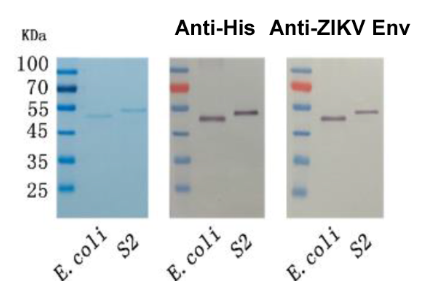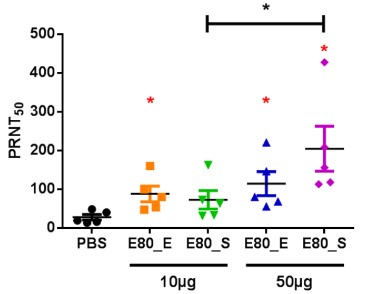On March 28th, 2018, Plos One published a research work entitled “Recombinant Zika virus envelope protein elicited protective immunity against Zika virus in immunocompetent mice” from Xia Jin’s unit, Institute Pasteur of Shanghai, Chinese Academy of Science.
Zika virus (ZIKV) is an emerging mosquito-transmitted flavivirus that belongs to the Flaviviridae family. It contains a single-stranded, positive-sense RNA genome. ZIKV was first isolated from a rhesus macaque in 1947, but it has caused very few human infections for six decades. Most human infections are manifested as a self-limited febrile illness that presented as low-grade fever, rash, headache, conjunctivitis, myalgia and arthralgia. But the unprecedented large Zika outbreaks in French Polynesia and South America more recently have revealed an association between ZIKV infection and the increased incidence of microcephaly in fetus and infants and Guillain-Barré syndrome in adults.
Recombinant subunit-based vaccine strategy is an alternative platform that warrants testing because of its remarkable safety, relative ease for antigen production, and modest cost. The choice of antigen is straightforward. Similar to other flaviviruses, the ZIKV RNA genome encodes one open reading frame (ORF) that is posttrasnaltionally processed into three structural proteins (C, capsid; prM, pre-membrane; E, envelope) and seven non-structural proteins (NS1, NS2A, NS2B, NS3, NS4A, NS4B and NS5). The outer surface of mature ZIKV virion consists of 180 copies of E glycoproteins, which is arranged into 90 antiparallel homodimers and anchored onto the virus lipid envelope via a transmembrane domain. The N-terminal ectodomain of an individual E glycoprotein (approximate 80% length of the entire E protein, herein as E80) is comprised of three distinct antigenic and structural regions (EDI, EDII and EDIII) that mediate viral attachment and post-entry endosomal fusion during the virus entry process. Thus, E protein is an obvious antigen of choice.
In this project, we constructed E protein-based subunit vaccines (ZIKV E80) in both E.coli and Drosophila expression systems, and examined the immunogenicity and protective efficacy of these two ZIKV E80 proteins. We found that both candidate vaccine products generated neutralizing antibodies and antigen-specific T cell responses. Importantly, these candidate vaccines conferred protection against ZIKV challenge in immunocompetent mice.
This study was supported in part by a National Key Program Project Grant from the Ministry of Science and Technology China, a National Science Foundation of China grant, and The Strategic Priority Research Program of the Chinese Academy of Sciences.
Link:
http://journals.plos.org/plosone/article?id=10.1371/journal.pone.0194860
Figure Legends
A. Two forms of recombinant ZIKV sub-unit vaccine candidate expression

B. The PRNT50 in immunocompetent mice


